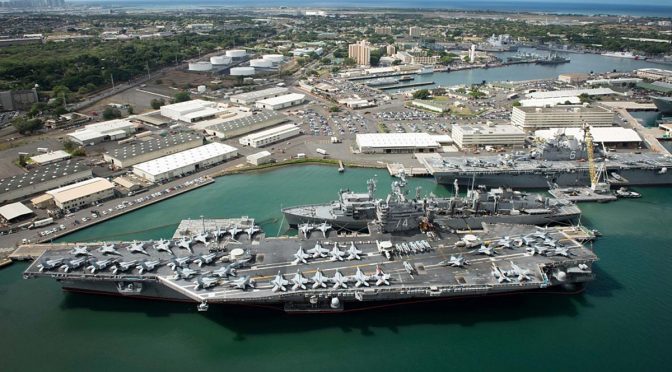Notes to the New CNO Topic Week
By J. Overton
It’s not all about the ships, the planes, or even the Sailors.
Every day, the majority of the U.S. Navy is spending its time on shore duty. It follows that shore installations are also where the majority of naval operations, strategy, and innovation are carried out. The Navy’s 71 remaining bases show amazing resilience. Some were first built in the days of sail, some were ravaged by wars, natural disasters, and political fluctuations, and yet still they ably sustain the modern Navy.
Ranging in size from the equivalent of a small village to a mid-sized city, some produce their own power, have malls, schools, airports, and wildlife refuges, all seemingly separate from their primary fleet support purpose.
But shore installations are the U.S. Navy’s most vital, complex, and resilient platforms, as close in form to a capital “ship” as we now have. However, they have their own unique critical vulnerabilities. Coastal areas tend to be the most populated, the most environmentally sensitive, most prone to disasters, and have the most desirable real estate. Multiple stakeholders share waterfront property with the Navy, and their interests will, at times, be at odds with a base’s operations or existence.
Bases are also the centerpieces of the Navy’s most controversial issues, or at least those issues most relevant to those outside of naval policy and strategy circles. Most citizens and Sailors are unaware or uninterested in LCS variants or FONOPS but may have visceral opinions on issues like jet noise, mold in government housing, and hazardous chemical plumes. These feelings are easily and frequently converted into impactful actions by political decision-makers.
Naval culture adds to base vulnerability by placing less value on bases than on mobile platforms. Ships, submarines, and aircraft elicit emotional attachments, are given personalities, and hold mystique far beyond that of any building, pier, or parking lot.
But when damaged or decommissioned, the former can often be returned to action. However, once a base is gone, its prospects for coming back into Navy service are very slim.
Recent “Big Navy” strategic documents and designs, however, totally neglect shore installations, save one mention in “Design 2.0” which calls out their use in community relations. Important as that role is, bases’ size, location, and presence means they are continuously carrying out effective naval strategy. Some of that is direct and traditional – overhauling ships, fueling aircraft, training submariners. But much of that is better described as “collateral strategy” – using the means available through local presence to establish global ends.
In the months ahead, the CNO will draft strategic documents – designs, white papers, or sailing directions – putting his orders down for how the Navy will “…be the Navy the nation needs now, and [how] we will build the Navy the nation needs to fight and win in the future.” Shore installations will play an integral role in achieving these goals. Hopefully they will receive the explicit, substantive inclusion they merit, and in so doing will help ensure that the Navy and the nation don’t forget seapower’s dry foundation.
J. Overton is a civilian employee of the U.S. Navy, was previously an adjunct professor for the Naval War College and Marine Corps Command and Staff College, and served in the U.S. Coast Guard. The views and opinions expressed are those of the author and do not necessarily state or reflect those of the United States Government.
Featured Image: An aerial view of ships moored at Joint Base Pearl Harbor-Hickam for Rim of the Pacific 2016. (U.S. Navy Combat Camera photo by Mass Communication Specialist First Class Ace Rheaume/Released)


And, I would add, don’t forget the outsized power inherent in bases astride key strategic locations. The British Navy at the height of Empire understood and practiced this well.
The US Navy now is critically dependent on forward logistics bases for resupply (if not the capital ships, certainly the auxiliaries that keep the capital ships sailing). Those areas of the world where bases are few and far between present significant logistical challenges even in peacetime.
China is busy playing Go. We would do well to heed our constellation of friendly or US bases worldwide, lest we turn around and find ourselves suddenly surrounded.